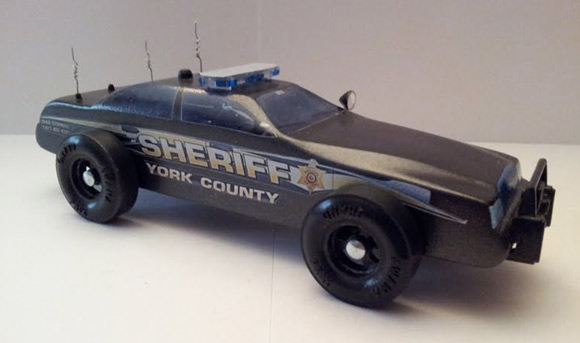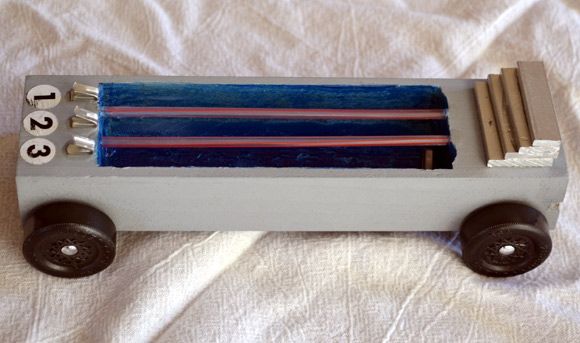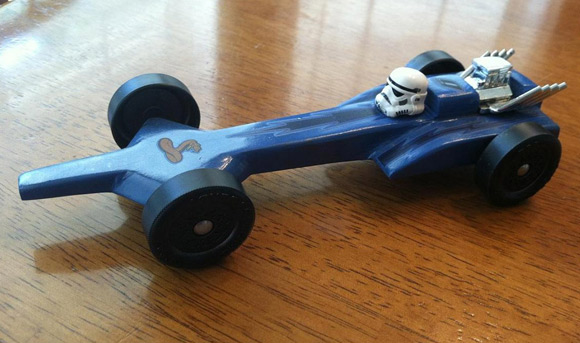– Feature Article – Streamlining the Weigh-in
– Pinewood Derby Car Showcase
– Q&A
Streamlining the Weigh-in
By Randy Davis
(An update of an article originally published December 1, 2004)
Have you been to a weigh-in/check-in that seemed chaotic? Did there appear to be a lack of organization or control of the event? All too often little thought is put into the organization of the weigh-in, which leads to irritated participants, and stressed officials. Fortunately, steps can be taken to transform the chaos into a streamlined process.
In today’s article I have provided information for race organizers to help the check-in flow smoothly. Of course, I have not exhausted this topic. If your organization has a smooth-running weigh-in, please e- mail your tips to me, and I will include them in a future newsletter.
In this article, I am assuming that the number of cars in the event will be reasonably large (greater than 50). If you have a smaller event, then some of the stations can be combined, and fewer officials will be required. However, all stations, equipment, and items mentioned in the article still need to be considered and accounted for.
Prelude
To lay the groundwork for a smooth flowing weigh-in, two preliminary items are required. Don’t set yourself up for failure by skipping these crucial items.
- One or more workshops – By having the official scale available at a workshop, many of the participants will be able to adjust the weight of their cars which will minimize the amount of adjustments that will need to be made at the weigh-in.
- Clear and complete rules – A good set of rules minimizes problems at the weigh-in. Unclear rules lead to confusion, arguments, and unnecessary stress on all involved. Make sure that all items specified in the rules will be inspected, and no inspection will occur for non- documented items.1
The Leader
Organization does not happen without preparation. If you want the weigh-in to go smoothly, then the event must be carefully planned, as should the race itself.
So who will do all this planning? Don’t just ask for a volunteer, and certainly don’t pick someone that has never experienced a pinewood derby! Instead, find someone that has good organizational skills. The person does not have to be an expert car builder, nor do they necessarily have to be a club official (unless your organization rules require it). But they do need to know how to plan, how to lead, and how to delegate.
Preparation
Now that the leader has been identified, they need to get on with the planning. Good planning should include identifying the best foot- traffic flow, recruiting and training of weigh-in officials, acquisition of the needed materials, etc. Plans would include a sketch of a floor layout, a list of materials and a list of weigh-in jobs, and a time-schedule to make it happen.
One point on recruiting; don’t make the mistake of recruiting too little help. The weigh-in leader should not plan to run a weigh-in station themselves. The leader will have enough to do with coordinating, answering questions, etc. If they run a station, that station will become a bottleneck.
Equipment
Here is a list of required equipment. I am sure you can think of other items as well:
- Weigh scales – I recommend one official scale, and one or more non- official scales (at least as accurate as the official scale). The non-official scales are used by racers to adjust the weight of the car. Then the car is weighed on the official scale before impounding.
- Official measuring devices – To check the car for compliance. These usually include a car body gauge and possibly a wheel gauge.2 Make sure that gauges are available for checking all specifications identified in the rules, but don’t test for items not sepecified in the rules.
- Tools – small screwdrivers (for removing and attaching underbody weight plates), 2 or more drills (for adjusting weight), pliers (for breaking weight plates), hacksaw (for cutting zinc rods), level (to make sure the scale is level).
- Supplies – lubricant, extra wheels, extra axles, weights (possibly Flex Weights – these can be sold to parents as needed), and stickers (or permanent markers) to number cars. We use black and silver permanent markers, and write the car number on the bottom-front of the car (black for light-colored cars, silver for dark-colored cars).
- Tables – Enough for each weigh-in station and for holding the impounded cars. Make sure the tables are stable and solid. The impound tables should be isolated so that only inspection officials have access.
- Car Immobilizers – The impound tables need something to prevent the cars from rolling. Inexpensive commercial solutions are available, or you can create your own solution using thick cords or wood slats taped lengthwise on the table (cars are placed perpendicular to the cord or wood).
Stations
Here are the basic stations (in sequence order):
- Registration Station – To register the owner (or verify the pre- registration).
- Inspection Station – To verify the compliance of the car to the rules.
- Repair Station – For owners to fix non-compliance issues.
- Weight Adjustment Station – For making gross weight adjustments – A non-official scale is located at the station for use by car owners. Using this non-official scale reduces congestion at the Weigh Station. Since car owners may be drilling lead at this station, it should be located in a place where lead fragments can easily be collected for disposal.
- Lube Station – For applying lubricant – Since graphite will be flowing, it should be located outside if possible.
- Official Weigh Station – Location of the official scale (make sure it is not under an air duct or in a draft) – Once the car passes weight, the car is impounded.
Training
Trained workers will greatly streamline the weigh-in, so make sure each person knows what to do. Specifically:
- Inspection station – The worker(s) need to be familiar with the rules, with the appearance of the wheels/axles in the car kit, and the use of the inspection devices. They also need a list of items to check for.
- Official Weigh Station – The worker needs to be familiar with using the scale, and have a procedure to follow (e.g., blow debris off scale, zero scale, weigh car). Also, a time duration should be established as to how long the car will sit on the scale before declaring it is compliant (some scales fluctuate, so I recommend a 5 second count before the weight is considered official).
Final Thoughts
A dad told me about his experience with their weigh-in. The child had done a lot of work on the car, and he was very proud of the result. However, they were novices and did not understand the importance of weight. At the weigh-in, their car weighed only 3.5 ounces. Without being asked, or given permission, the official took the car to the Weight Adjustment Station and proceeded to drill holes in the back of the car. The child was very upset and started crying as he watched the “destruction” of his masterpiece.
The moral of the story? The job of the inspection official is to verify that the car meets the specifications, not to correct problems. Any adjustments to a car (weight, lubrication, etc.) should be done by the owners, unless the owners need help and specifically give permission to the officials to render assistance. This policy helps reinforce that the owners are responsible for their own car, limits the risk of an official damaging a car, and minimizes the number of required weigh-in officials.3
Conclusion
As you plan your weigh-in this year, spend the time to organize it well. You will find that planning will streamline the event, making it more enjoyable for car owners and officials.
1See: Volume 11, Issue 1 – “Do’s and Don’t for Race Leaders”.
2Maximum Velocity offers both Car and Wheel Go/No-go Gauges.
3More information on race official assistance can be found in Volume 10, Issue 10 – “Leader Help – How Much is Too Much?”.
Pinewood Derby Car Showcase
Sheriff Cruiser – Matt Penza
The fastest car in our race was my sheriff’s car. This is the exact car that I use on duty. Well a replica. I took photos of my sheriff’s car and downloaded them onto the computer. After sizing the photos I made stickers out of them. The antennas are also the same on the real sheriff’s car. As you can see I added a light bar after modifying it, a spotlight, and a push bar. This car weighed exactly 5 ounces. With your Awana Speed Wheels and axles, this car set a track record!!!
Swimming Pool – David Kenison
My son, who just crossed over to Boy Scouts, decided to make his last pinewood derby car to look like a swimming pool. He is on a swim team and last year he made an Award Car and the previous year was a Swimming Car. So it seemed appropriate to make a pool this year.
Jedi’s Nightmare – Rodney Earp
Here is my son’s 2012 car. It was designed, built and painted by him. It won 1st in the pack and 21st in the district. We found out that a pointed front end works okay if the track sensors are tabs. But at the district race, sensor lights were used. I have video showing the car not tripping the sensor till somewhere around the front wheel area.1 So, consider having a wider front end when you design a car next year. Oh, by the way, my son uses the Storm Trooper each year on his car. The Storm Trooper has done quite well using your lube, and other stuff from your site. Thanks for all you do for pinewood derby racing!
1For more information on this issue, please see: Volume 7, Issue 2 – “Is Your Finish Line Providing Accurate Results”
Q&A
Is there is a difference between using an aluminum, plastic or wood track? Why would a car perform better on one type of track than another?
Regarding tracks, there is a difference depending on the material and length.
- Wood tracks tend to be rougher. An aggressively rear-weighted car may be unstable on a wood track. Also, the center guide rail may be rough, so the rail-riding technique may not work as well.
- Aluminum tracks tend to be very smooth so aggressive rear-weighting is usually a key to performance. Rail-riding is also a big help.
- Plastic tracks can have center or side lane guides. Plastic tracks with center guides are generally treated the same as aluminum tracks. Plastic tracks with side guides can lead to problems with wheels that have raised lettering. Removing the lettering may be helpful.
- Track length also affects performance. For short (32-45 feet), aggressive rear-weighting is usually the winning strategy. For longer tracks, the balance point needs to be made less aggressive.
After reading about liquid vs graphite lubes, it looks like liquid lube is easier overall, does not require as much time for application or careful “run-in”, and may last more evenly through the course of the event. Our pack has said they think liquid lubes are too messy and give too much of an advantage. I don’t believe this is the case. Everyone knows about liquid lubes (we publish speed hints to level the field), so it seems like it would be fair to allow liquid lubes. Your thoughts, and how would you convince our pack/district to allow liquid lubes?
I believe that if applied properly, a good liquid lube (such as Krytox 100) is cleaner, easier to use, and as fast, if not faster than graphite. The problem with liquids is that people tend to put on too much, so the liquid runs out of the bore. But if you put that much on, you will just be slowing down your car. When applied properly, a liquid lube should not be noticeable.
In our race we allow any lube, but all excess lube must be removed before the cars are turned in (this is in the rules). That includes graphite, oil, or anything else. The track fouling we see comes from excess graphite, not excess oil.
To convince the leadership to allow liquid lubes, you could explain that oils are cleaner than graphite but both types of lubes are messy if used improperly. The rules would need to be updated to clarify that over-lubed cars would not compete.
Want Answers?
Do you have a pinewood derby-related question? If so, e-mail us your question.We answer all questions by e-mail, but not every question will appear in the Q&A section of the newsletter.
Back Issues
Are you a new subscriber, or have you missed some of the previous newsletters? Don’t miss out; all of the issues for Volume 5 through Volume 17 are posted on our web site.
Newsletter Contributions
We welcome your contributions. If you would like to contribute an article, a web site review, a speed tip, or a pinewood derby memory, please e-mail us.
Subscription Information
The Pinewood Derby Times is a free e-newsletter focused on pinewood derby racing. It is published biweekly from October through March.
If you haven’t already done so, please forward this issue to your pinewood derby friends. But please don’t subscribe your friends. Let them decide for themselves. Thanks.
If this newsletter was forwarded to you, why not subscribe to receive this newsletter. There is no cost, and your e-mail address is safe, as we never sell or share our distribution list.
To subscribe, send a blank e-mail to
[email protected]
You will receive a confirmation e-mail. Reply to the confirmation e-mail and you will start receiving the Pinewood Derby Times with the next issue.
Randy Davis, Editor, Pinewood Derby Times
E-Mail: [email protected]
(C)2018, Maximum Velocity, Inc. All rights reserved. Please do not reprint or place this newsletter on your web site without explicit permission. However, if you like this newsletter we grant permission, and encourage you to e-mail it to a friend.
Maximum Velocity disclaims any personal loss or liability caused by utilization of any information presented in this newsletter.
The Pinewood Derby Times is not specific to, and is not affiliated with the Boy Scouts of America, YMCA, Awana, or any other organization.
(R)Maximum Velocity is a registered trademark of Maximum Velocity, Inc.
(R)Pinewood Derby is a registered trademarks of the Boys Scouts of America.
(R)Awana is a registered trademark of Awana Clubs International.
All other names are trademarks of their respective owners.



